~by Texas Homesteader ~
Inspecting Beehives. We have the hives, we have the bees – what’s next? Come with us as we inspect the inside of the new bee hives!
(Note: Some links in this post will take you to other related articles for further information. But links preceded with * are affiliate links. If you click and buy something I could receive a tiny commission.)
There are many who are interested in raising bees, so we’ve been asked to share our experience.
I’ve written about the beekeeping preparation steps that were necessary before we ever obtained our first bees in this Preparation Post.
And I’ve written another post about what to do when you actually Obtain your Bees. A pretty complete list is included at the bottom of this article. So if you haven’t read those posts be sure to check them out.
But now that we have our bees, we can’t just put ’em out there & let them do their thing… There’s a rhythm to tending to the hives to assure a healthy, thriving, productive hive.
Observing New Honeybee Hive Activity
RancherMan visually checks the activity at the new hives each day by standing outside the bee pen that we’ve sectioned off for our beehives. He watches the bee’s activity at each new hive, but he doesn’t disturb the bees or their hives during these daily visual inspections.
He’s using this visual inspection time to compare general activities of each hive. Do both hives look to be active? Are many bees coming & going from each new hive? Are there any stark differences between the two hives’ activities?
But sometimes it’s important to dig into those hives for maintenance & checking.
Feeding Your Honeybees
Especially when your hive is new the bees may need a little help with feeding by adding feeders filled with 1 part water to 1 part sugar.
Our feeder seemed to be emptied about every 5 days. So RancherMan would refill the feeder as it was emptied.
Types of Bee Feeders For Your Beehives
External Jar Bee Feeders
The easiest feeder to use was an *external jar feeder. We placed it at the entrance of each hive.
It was simple to monitor the level of syrup that remained in the feeder because we could see it from outside the hive. And we could refill the external jar feeder without breaking into the hive and disturbing the bees.
But we found those external jar feeders often leaked so bad that they attracted ants. We didn’t like that at all!
Internal Frame Bee Feeders
We removed the external jar feeder from the entrance of the hives and RancherMan placed one of the *frame feeders inside each of our hives.
Drawbacks Of Internal Bee Frame Beehive Feeders
-
- Monitoring feed consumed is difficult since the frame feeder is inside the hive.
- It’s necessary to open up the hive & disturb the honeybees to refill a frame feeder.
- A frame feeder takes the place of a frame the bees would be working on – so a full frame’s production is lost.
But even with these drawbacks, the internal frame feeder is our preference for times when we need to feed the bees. And we felt there was much less robbing by bees in other hives when using a frame feeder.
How Often Should You Inspect A Beehive?
We’ve read that it’s best not to disturb the hive unless you’re doing a physical inspection.
From what we’re learning at our beekeepers seminars & association meetings, it’s fairly typical for beekeepers to inspect the inside of new hives about once each week or so to check the health of the hive. (some beekeepers go into the hives more often, some less often. But we were told about a week is typical)
What Do You Look For During Beehive Inspection?
The following are things to look for during a beehive inspection.
-
- Do you see any hive beetles or Varroa mites? If so, now is the time to start taking action to assure they don’t compromise the health of your hive.
- Is the queen active & present? The queen is larger and pretty easy to detect.
- What are the stages of the larvae (baby bees)?
- Are new cells being formed and eggs still being laid?
- How much comb is being drawn on the new frames?
You’re basically checking the health & growth of the hive.
Protective Clothing For Beekeeping
Now although there are all manner of beekeeping apparel available, RancherMan’s typically comfortable with heavy jeans, a long-sleeve shirt worn OVER a short-sleeve tucked-in for double layering, leather boots, beekeeper’s gloves and beekeeper’s veil.
We’ve been told to ALWAYS wear the veil since bee stings in an eye can be very dangerous and damage can be permanent. So one way or the other we always are at least sporting a veil.
The links below will show you what those items look like, but typical beekeeping attire is:
-
- Long-sleeved shirt
- *Beekeeper’s Veil
- (or *Vented Jacket With Veil)
- Heavy Beekeepers Leather Gloves with Arm Protection
- Heavy pants (we wear heavy denim jeans)
- Sturdy shoes (we often tuck our jeans into boots)
What Time Of Day Is Best For Inspecting A Beehive?
When inspecting the hive it’s best to wait until middle of the day when many of the hive’s occupants are out foraging. That way you’re looking through fewer bees to more easily inspect the frames.
It’s common to smoke the hive before opening up the hive boxes to distract the bees.
Smoking the hive makes the bees believe there’s a fire close by. So they go into a frenzied feeding mode to prepare themselves for this hardship. Even so, you don’t want to get into or smoke the hive any more often than you have to.
Keeping A Bee Inspection Journal
RancherMan likes to keep a journal of his observations. He can compare notes from this inspection vs last inspection and see any trends or growth at a glance. His bee journal shows:
Bee Journal:
(DATE) First trip to open hives. Bees very calm.
First hive (brown) strong with bees already drawing small amount of comb on new frames. Queen found on 3rd frame in. Installed inner lid.
Second hive (yellow/blue) strong but not as strong as first. Almost no bees on new frames. Queen found on 2nd frame in. Installed inner lid.
Put on jar feeders with 1/1 syrup on both hives.
(DATE) Second trip to open hives. Bees calm and very active.
First hive – comb growing on new frames,20% drawn. Saw queen 3rd frame in.
Second hive – very active. Saw new bee emerging. Still little activity on new frames. Did not see queen. One hive beetle.
———————————————————————————–
(DATE) Third trip into hives. Both hives very active and increased in size. Smaller hive appears to have caught up. All 4 exterior frames have significant comb on insides. Did not see either queen but saw lots of brood. No beetles.
When To Expand A Honeybee Hive
It’s important during these weekly inspections inside the hives to also determine the appropriate time to place another deep box with frames on a full hive.
If the bees have filled up all their current frames with brood and comb, they’ll start looking for a place to expand. And oftentimes that means they’ll swarm.
When they swarm they will take the queen and go look for another place to live. That’s certainly a losing proposition for a beekeeper who has spent time & money to purchase & care for his own colony of bees.
So you want to make sure there’s still plenty of frames for the bees to work so they won’t get any movin’ out ideas.
A second box with frames allows them room to expand and reduces the chances of swarming. It also offers opportunity to grow the hive. That means more brood, more bees, and of course more HONEY!
More often than not you’ll determine after your hive inspection that all is fine. If so, you’ll carefully close the hive and leave them to their bee bzzzzzness.
~TxH~
BEEKEEPING SERIES:
- Preparing For the Hives
- Obtaining Your Bees
- Inspecting Your Hives
- Feeding Bees With A Frame-Feeder
- Knowing When To Expand The Hive
- Performing A Walk-Away Split
- Performing A Frame-Swap Split
- 5-Minute Beehive Stand
- Adding A Honey Super To Your Hive
- Catching A Bee Swarm (With Video)
- Requeening A Beehive – Things We Didn’t Know
- Make FOUR 5-Frame Nuc Boxes From 1 Sheet of Plywood!
- Varroa Mite Treatment For Your Apiary
- Preparing Your Hive For Honey Harvest
- Proper Honey Bottling Tips
- Purifying Your Beeswax
- MYO Beeswax Lip Balm
- Homemade Beeswax Jar Candles
- Beeswax Wraps – A Natural Solution To Plastic Wrap
…And MUCH More!
See All Our Beekeeping Posts
C’mon by & sit a spell! Come hang out at our Facebook Page . It’s like sitting in a front porch rocker with a glass of cold iced tea. There are lots of good folks sharing! And you can also follow along on Pinterest, Twitter or Instagram
If you’d like to receive an email when a new blog post goes live,
subscribe to our Blog!

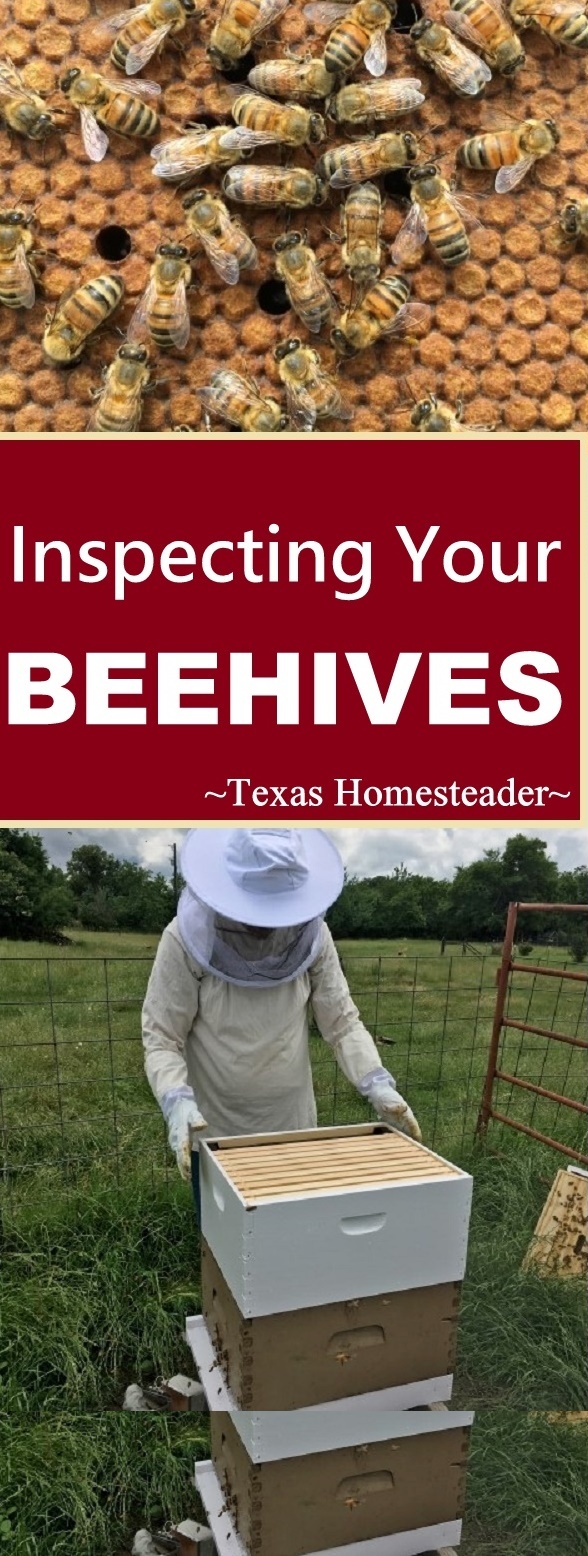
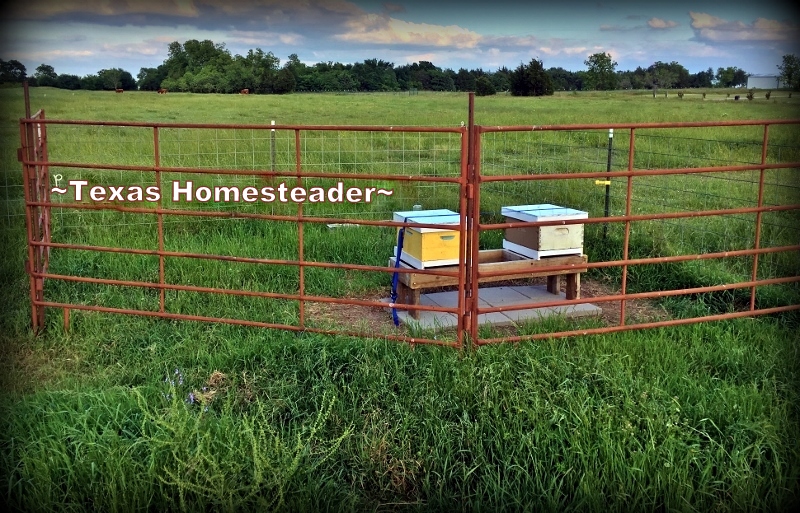
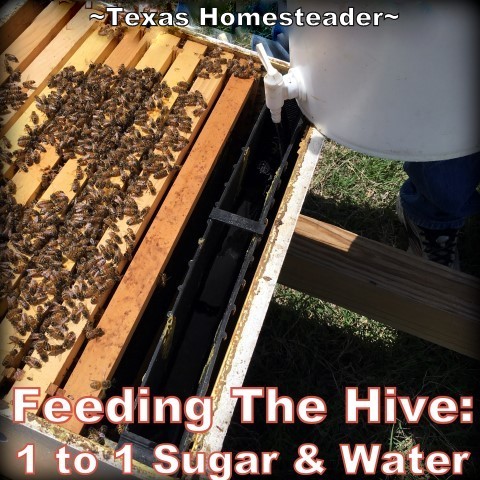
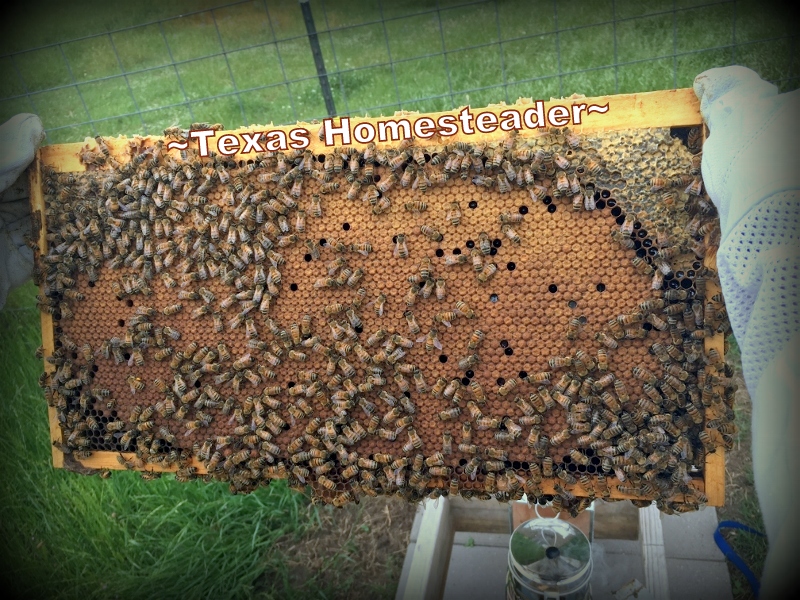
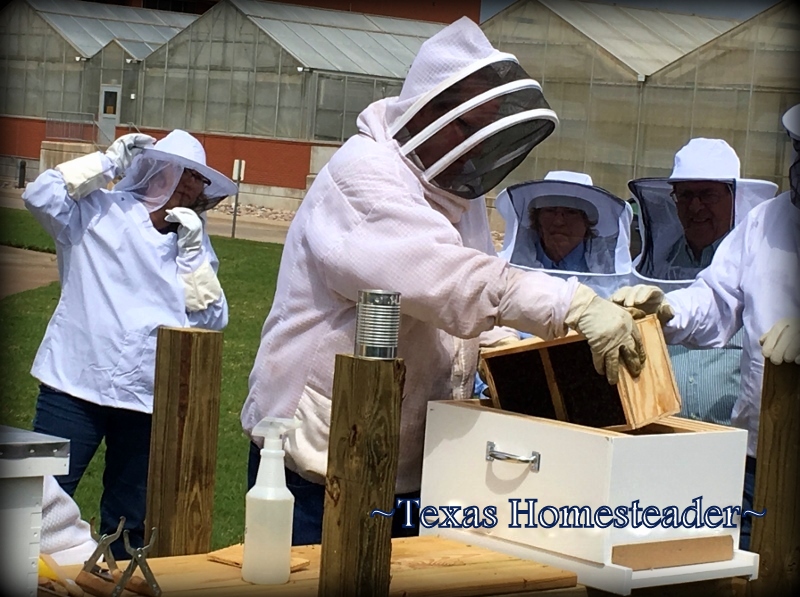
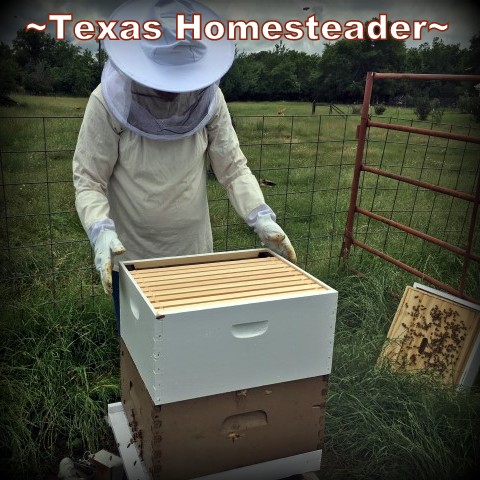


Thank you so much for all the information you have shared. My husband and I are going to get bees but I am worried about the FIRE ANTS. How do you keep them away from hives??? What do you treat with?
Thanks
Ants can be a problem around beehives. I’ve heard that wood mulch attracts ants, so we’ve opted to keep it away from our apiary. A few months ago instead of rocks or mulch we actually laid down outdoor ‘astro-turf’ type of material in the apiary and set our hive stands on top to keep grass from growing around or beneath our hives. I haven’t written an article about that yet as I’m still evaluating the effectiveness. So far it’s working great and there will be no grass to mow around our beehives, a maintenance task that we’d rather not do as it often irritates bees. And so far no trouble with ants either. Some beekeepers put the legs of their elevated hives into a cup of some sort (empty tin can maybe? Depending upon the width of the wooden leg) and keep the cup filled with oil. Good luck with your bees Sharon – they’re so much fun! ~TxH~
What great info for someone interested in starting to keep bees. I wonder if we’re allowed to have them in our city? Thanks for sharing with Simply Natural Saturdays.
I remember going garage-saleing in west Texas and one of the houses we stopped at was selling honey from their own hives. They asked if we wanted to see and took us into their backyard to see the hives they had set up right against the house. Love it! ~TxH~
Hubby and I are interested in bees, but not quite ready to take the pluge ourselves. There is a class we can take locally to learn more, but haven’t take it yet. Thanks for posting this on #sustainablesunday and providing this insight into beekeeping.
We started going to classes months before we got our bees Katy, it’s so good you have some local options for them. Living out here we had to trek to various places to glean our education, and we’re still learning! ~TxH~
Very nice and informative article, with great pictures to boot! My husband and I are hoping to get bees next year. Thanks for sharing!
OMGosh this beekeeping endeavor has been surprisingly fulfilling, Jamie. When I go to the garden & see all the pollination going on I assume those are OUR girls doin’ their thing! ~TxH~
Very interesting. I just heard about ‘renting’ bee’s. Who would have thought? Not me.
Thanks for linking at The Art of Homemaking. I always enjoy visiting you!
Come over and see me at My Journey Back-the Journey Back!
Me too Sherry – who’d have thought?? And they typically pay you with HONEY??!! Yes please! ~TxH~
We extracted honey for the third time last weekend! Beekeeping really is amazing and I love your beekeeping journal idea. We might have to start doing that.
Very very educative….you have made a chapter of a book already. I love the journal idea. It makes a lot of sense.
Thank you for sharing your journey with us.
Hugs and blessings to you
Just checked in on our hive yesterday and was pleased to see that they’re doing fine. Keeping bees used to be much simpler than it is now. When we started out years ago all we really had to do was collect the honey once or twice a year. But with the coming of varroa mites and CCD now it’s hard to keep them alive. I’m grateful for posts like this and folks who take the time to share wisdom. There’s a lot at stake!
That’s what I’m hearing too Bill. We’re researching various ways to treat varroa, we’re thinking of using the thymol crystals since it was the highest recommendation from the USDA research. What are you using? Would you recommend it? We’d like to stay as natural as possible but realize that we’ll need to move up the ladder if natural doesn’t keep ’em in check. I’d love to hear what other beekeeper’s experiences are! ~TxH~
Bees are so interesting and so important. Thanks for being a caretaker to the worlds future. I admire you 🙂
This is really fascinating. Thank you so much for sharing it
Thank you Tammy! So fascinating. ..
We’re learning so much Laurinda but from what I’m hearing the learning will be ongoing as long as we raise bees! I hope to be able to share what we do with our bees for others to learn from, but each beekeeper adapts the procedures to what works best for them. Knowledge is power! ~TxH~
Busy as a Bee they say. :} Interesting article Tammy
Sent your link to a couple of guys down Houston way who also has bees and thought they just might be interested in reading about your adventures and set up.